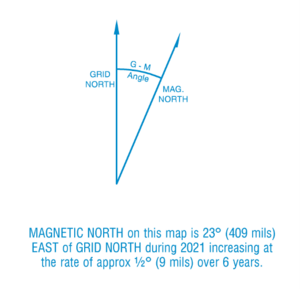A geodetic datum maintains coordinate accuracy on a curved surface, but a projection distorts coordinates to provide a more visually favourable representation. Projections often include the convergence, scale factors and declination as additional parameters.
Convergence and scale factors account for the distortion caused by transforming a coordinate on the Earth’s curved surface to a map or other flat surface. Declination is the difference between magnetic north and grid north, which varies depending on the location
Convergence factors indicate the angle between true north, which we would see on a curve, and grid north, which we would see on a flat surface. True north always points towards the North Pole, while grid north is specific to the projection. Like other angles it is shown in the format degrees (°), minutes (‘), and seconds (“).
For example: Convergence Factor: 2° 30' 45"
Two different sign conventions are commonly used with convergence factors. The Gauss-Bomford Convention is most common in Europe and North America, while the Survey Convention is used in Australia and New Zealand. For the New Zealand Transverse Mercator 2000 (NZTM2000) and New Zealand Geodetic Datum 2000 (NZGD2000) Meridional Circuits:
- grid convergence is positive when grid north lies to the west of true north (when the point is east of the central meridian or map centre)
- grid convergence is negative when grid north lies to the east of true north (when the point is west of the central meridian or map centre)
Scale factors are how much a distance on the map differs from reality, providing a scale for accurate interpretation. Scale factors are expressed as a ratio, such as 1.02 (indicating a 2% enlargement).
Rotation is used to modify the north direction of a map. In most modern datums true north (or geographic north) is aligned with the Earth’s natural poles (that is, the meridian). Grid north is in the same general direction, but as a flat projection of curved surface these two values will separate at an angle known as declination.
Most topographic maps include a diagram showing the magnetic declination. This is the angle between grid north and magnetic north (as shown by a compass). The value varies depending on location, and changes over time as the magnetic poles move at a rate of about 1 minute every 12 years.
For example:

To compute magnetic declination for anywhere in the world see the geomagnetic calculators on the NOAA (National Oceanic and Atmospheric Administration, USA) website:
Convergence, scale factors and declination help to create a map from a curved surface but are not always perfect. For example, the convergence factor's impact increases with distance from the central meridian (a line that runs north-south through the centre of the projection),distorting angles and distances. At the same time, the scale factors can expand or contract as the projection’s area increases.
As a result, a cartographer or geospatial professional should carefully consider the accuracy that is required and the purpose of the map when they decide which projection to use for an area.